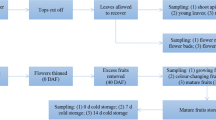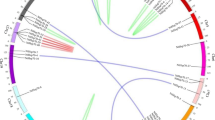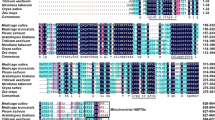Abstract
Members of the family of 70-kD heat shock proteins (HSP70 s) play various stress-protective roles in plants. In this study, a wheat HSP70 gene was isolated from a suppression subtractive hybridization (SSH) cDNA library of wheat leaves infected by Puccinia striiformis f. sp. tritici. The gene, that was designated as TaHSC70, was predicted to encode a protein of 690 amino acids, with a molecular mass of 73.54 KDa and a pI of 5.01. Further analysis revealed the presence of a conserved signature that is characteristic for HSP70s and phylogenetic analysis demonstrated that TaHSC70 is a homolog of chloroplast HSP70s. TaHSC70 mRNA was present in leaves of both green and etiolated wheat seedlings and in stems and roots. The transcript level in roots was approximately threefold less than in leaves but light–dark treatment did not charge TaHSC70 expression. Following heat shock of wheat seedlings at 40°C, TaHSC70 expression increased in leaves of etiolated seedlings but remained stable at the same level in green seedlings. In addition, TaHSC70 was differentially expressed during an incompatible and compatible interaction with wheat-stripe rust, and there was a transient increase in expression upon treatment with methyl jasmonate (MeJA) treatment. Salicylic acid (SA), ethylene (ET) and abscisic acid (ABA) treatments had no influence on TaHSC70 expression. These results suggest that TaHSC70 plays a role in stress-related responses, and in defense responses elicited by infection with stripe rust fungus and does so via a JA-dependent signal transduction pathway.



Similar content being viewed by others
References
de Maio A (1999) Heat shock proteins: facts, thoughts, and dreams. Shock 11:1–12
Lindquist S, Craig EA (1988) The heat shock proteins. Annu Rev Genet 22:631–677
Vierling E (1991) The roles of heat shock proteins in plants. Annu Rev Plant Physiol Plant Mol Biol 42:579–620
Lin BL, Wang JS, Liu HC, Chen RW, Meyer Y, Barakat A, Delseny M (2001) Genomic analysis of the Hsp70 superfamily in Arabidopsis thaliana. Cell Stress Chaperones 6:201–208
Boorstein WR, Ziegelhoffer T, Craig EA (1994) Molecular evolution of the HSP70 multigene family. J Mol Evol 38:1–17
Flaherty KM, DeLuca-Flaherty C, McKay DB (1990) Three-dimensional structure of the ATPase fragment of a 70 K heat-shock cognate protein. Nature 346:623–628
Zhu X, Zhao X, Burkholder WF, Gragerov A, Ogata CM, Gottesman ME, Hendrickson WA (1996) Structural analysis of substrate binding by the molecular chaperone DnaK. Science 272:1606–1614
Sheffield WP, Shore GC, Randall SK (1990) Mitochondrial precursor protein. Effects of 70-kilodalton heat shock protein on polypeptide folding, aggregation, and import competence. J Biol Chem 265:11069–11076
Glover JR, Lindquist S (1998) Hsp104, Hsp70, and Hsp40: a novel chaperone system that rescues previously aggregated proteins. Cell 94:73–82
Mayer MP, Bukau B (2005) Hsp70 chaperones: cellular functions and molecular mechanism. Cell Mol Life Sci 62:670–684
Marshall JS, DeRocher AE, Keegstra K, Vierling E (1990) Identification of heat shock protein hsp70 homologues in chloroplasts. Proc Natl Acad Sci USA 87:374–378
Bush GL, Meyer DI (1996) The refolding activity of the yeast heat shock proteins Ssa1 and Ssa2 defines their role in protein translocation. J Cell Biol 135:1229–1237
Pratt WB, Toft DO (2003) Regulation of signaling protein function and trafficking by the hsp90/hsp70-based chaperone machinery. Exp Biol Med 228:111–133
Gabai VL, Meriin AB, Mosser DD, Caron AW, Rits S, Shifrin VI, Sherman MY (1997) Hsp70 prevents activation of stress kinases. A novel pathway of cellular thermotolerance. J Biol Chem 272:18033–18037
Heikkila JJ, Papp JET, Schultz GA, Bewley DJ (1984) Induction of heat shock protein messenger RNA in maize mesocotyls by water stress, abscisic acid, and wounding. Plant Physiol 76:270–274
Dhankher OP, Drew JE, Gatehouse JA (1997) Characterisation of a pea hsp70 gene which is both developmentally and stress-regulated. Plant Mol Biol 34:345–352
Chong KY, Lai CC, Lille S, Chang C, Su CY (1998) Stable overexpression of the constitutive form of heat shock protein 70 confers oxidative protection. J Mol Cell Cardiol 30:599–608
Uenishi R, Gong P, Suzuki K, Koizumi S (2006) Cross talk of heat shock and heavy metal regulatory pathways. Biochem Biophys Res Commun 341:1072–1077
Agarwal P, Agarwal PK, Joshi AJ, Sopory SK, Reddy MK (2010) Overexpression of PgDREB2A transcription factor enhances abiotic stress tolerance and activates downstream stress-responsive genes. Mol Biol Rep 37(2):1125–1135
Jaattela M (1999) Esca** cell death: survival proteins in cancer. Exp Cell Res 248:30–43
Jolly C, Morimoto RI (2000) Role of the heat shock response and molecular chaperones in oncogenesis and cell death. J Natl Cancer Inst 92:1564–1572
Mayer MP (2005) Recruitment of Hsp70 chaperones: a crucial part of viral survival strategies. Rev Physiol Biochem Pharmacol 153:1–46
Kanzaki H, Saitoh H, Ito A, Fujisawa S, Kamoun S, Katou S, Yoshioka H, Terauchi R (2003) Cytosolic HSP90 and HSP70 are essential components of INF1-mediated hypersensitive response and non-host resistance to Pseudomonas cichorii in Nicotiana benthamiana. Mol Plant Pathol 4:383–391
Aranda MA, Escaler M, Wang D, Maule AJ (1996) Induction of HSP70 and polyubiquitin expression associated with plant virus replication. Proc Natl Acad Sci USA 93:15289–15293
Ventelon-Debout M, Delalande F, Brizard JP, Diemer H, Van Dorsselaer A, Brugidou C (2004) Proteome analysis of cultivar-specific deregulations of Oryza sativa indica and O. sativa japonica cellular suspensions undergoing rice yellow mottle virus infection. Proteomics 4:216–225
Panthee DR, Yuan JS, Wright DL, Marois JJ, Mailhot D, Stewart CN Jr (2007) Gene expression analysis in soybean in response to the causal agent of Asian soybean rust (Phakopsora pachyrhizi Sydow) in an early growth stage. Funct Integr Genomics 7:291–301
Yu XM, Yu XD, Qu ZP, Han QM, Guo J, Huang LL, Kang ZS (2007) Construction of wheat SSH cDNA library induced by Puccinia striiformis and analysis of expressed sequence tags. Acta Phytopathol Sin 37:50–55
Cao Z, **g JX, Wang M, Shang H, Li Z (2003) Relation analysis of stripe rust resistance gene in wheat important cultivar suwon 11, suwon 92 and hybrid 46. Acta Bot Boreal-Occident Sin 23:64–68
Li ZF, **a XC, Zhou XC, Niu YC, He ZH, Zhang Y, Li GQ, Wan AM, Wang DS, Chen XM, Lu QL, Singh RP (2006) Seedling and slow rusting resistance to stripe rust in Chinese common wheats. Plant Dis 90:1302–1312
Kang Z, Li Z (1984) Discovery of a normal T. type new pathogenic strain to Lovrin10. Acta Cllegii Septentrionali Occidentali Agriculturae 4:18–28
Zhang HB, Zhang DB, Chan J, Yang YH, Huang ZJ, Huang DF, Wang XC, Huang RF (2004) Tomato stress responsive factor TSRF1 interacts with ethylene responsive element GCC box and regulates pathogen resistance to Ralstonia solanacearum. Plant Mol Biol 55:825–834
Pfaffl MW (2001) A new mathematical model for relative quantification in real-time RT-PCR. Nucleic Acids Res 29:e45
Guy CL, Li QB (1998) The organization and evolution of the spinach stress 70 molecular chaperone gene family. Plant Cell 10:539–556
Francki MG, Berzonsky WA, Ohm HW, Anderson JM (2002) Physical location of a HSP70 gene homologue on the centromere of chromosome 1B of wheat (Triticum aestivum L.). Theor Appl Genet 104:184–191
Keiichi M, Kanako K, Etsuo S, Naoto K, Tadasu SI, Yuji K, Yukiko Y, Yasunari O (2006) Tissue expression map of a large number of expressed sequence tags and its application to in silico screening of stress response genes in common wheat. Mol Gen Genomics 276:304–312
Liu HT, Li B, Shang ZL, Li XZ, Mu RL, Sun DY, Zhou RG (2003) Calmodulin is involved in heat shock signal transduction in wheat. Plant Physiol 132:1186–1195
Sung DY, Vierling E, Guy CL (2001) Comprehensive expression profile analysis of the Arabidopsis Hsp70 gene family. Plant Physiol 126:789–800
Wang HS, Coffreda M, Leustek T (1993) Characteristics of an Hsp70 homolog localized in higher plant chloro plasts that is similar to DnaK, the Hsp70 of prokaryotes. Plant Physiol 102:843–850
Kropat J, Oster U, Rüdiger W, Beck C (2000) Chloroplast signalling in the light induction of nuclear HSP70 genes requires the accumulation of chlorophyll precursors and their accessibility to cytoplasm/nucleus. Plant J 24:523–531
Wang CF, Huang LL, Buchenauer H, Han QM, Zhang HC, Kang ZS (2007) Histochemical studies on the accumulation of reactive oxygen species (O2 − and H2O2) in the incompatible and compatible interaction of wheat—Puccinia striiformis f.sp. tritici. Physiol Mol Plant Pathol 71:230–239
Scarpeci TE, Zanor MI, Carrillo N, Mueller-Roeber B, Valle EM (2008) Generation of superoxide anion in chloroplasts of Arabidopsis thaliana during active photosynthesis: a focus on rapidly induced genes. Plant Mol Biol 66:361–378
Kunkel BN, Brooks DM (2002) Cross talk between signaling pathways in pathogen defense. Curr Opin Plant Biol 5:325–331
de Torres-Zabala M, Truman W, Bennett MH, Lafforgue G, Mansfield JW, Rodriguez Egea P, Bogre L, Grant M (2007) Pseudomonas syringae pv. tomato hijacks the Arabidopsis abscisic acid signalling pathway to cause disease. EMBO J 26:1434–1443
Amici C, Rossi A, Santoro MG (1995) Aspirin enhances thermotolerance in human erythroleukemic cells: an effect associated with the modulation of the heat shock response. Cancer Res 55:4452–4457
Fawcett TW, Xu Q, Holbrook NJ (1997) Potentiation of heat stress-induced hsp70 expression in vivo by aspirin. Cell Stress Chaperones 2:104–109
Creelman RA, Mullet JE (1997) Oligosaccharins, brassinolides, and jasmonates: nontraditional regulators of plant growth, development, and gene expression. Plant Cell 9:1211–1223
Reymond P, Farmer EE (1998) Jasmonate and salicylate as global signals for defense gene expression. Curr Opin Plant Biol 1:404–411
Leon J, Rojo E, Sanchez-Serrano JJ (2001) Wound signalling in plants. J Exp Bot 52:1–9
Zahur M, Maqbool A, Irfan M, Barozai MY, Qaiser U, Rashid B, Husnain T, Riazuddin S (2009) Functional analysis of cotton small heat shock protein promoter region in response to abiotic stresses in tobacco using Agrobacterium-mediated transient assay. Mol Biol Rep 36(7):1915–1921
Acknowledgements
We thank Dr. **-Rong Xu at Purdue University for critical reading of this manuscript. This work was financially supported by the National High Technology Research and Development Program of China (2006AA10A104), the Program for Changjiang Scholars and Innovative Research Team in University, Ministry of Education of China (No. 200558), the Nature Science Foundation of China (No. 30671350), the 111 Project from Ministry of Education of China (No. B07049), the Key Project of Chinese Ministry of Education (No. 107104), the Program for Excellent Young Scholars in Northwest A&F University and the Innovative Program for the Undergraduates in Northwest A&F University.
Author information
Authors and Affiliations
Corresponding author
Additional information
Ying-Hui Duan and Jun Guo contributed equally to this work.
Electronic supplementary material
Below is the link to the electronic supplementary material.
Rights and permissions
About this article
Cite this article
Duan, YH., Guo, J., Ding, K. et al. Characterization of a wheat HSP70 gene and its expression in response to stripe rust infection and abiotic stresses. Mol Biol Rep 38, 301–307 (2011). https://doi.org/10.1007/s11033-010-0108-0
Received:
Accepted:
Published:
Issue Date:
DOI: https://doi.org/10.1007/s11033-010-0108-0




